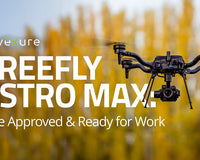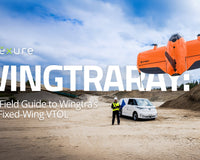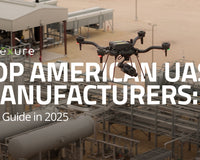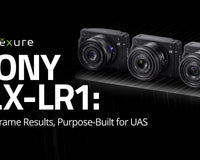In the rapidly evolving world of aerial imaging, LiDAR drone technology is becoming a game-changer for industries that depend on precise, real-time data. Whether it’s surveying rugged terrain, tracking stockpile volumes in construction or mining, mapping dense forest canopies, or inspecting utility and power lines, drones equipped with LiDAR sensors deliver actionable insights faster—and often more accurately—than traditional methods. Unlike standard photogrammetry, aerial LiDAR solutions can penetrate foliage and other obstructions, creating intricate 3D point clouds of the environment below.
The surge in demand for LiDAR for drones reflects a broader shift in how companies manage their most critical assets. Combining advanced positioning systems (like RTK or GNSS) with laser-based measurement, a drone LiDAR survey can drastically reduce the time and costs associated with ground-based surveys or manned aircraft flights.
In this blog, we’ll explore seven standout LiDAR camera and sensor solutions on the market right now—each with unique features designed to support diverse applications across industry sectors. Let’s dive in.
How LiDAR Works
To appreciate the transformative power of LiDAR-equipped drones, it helps to understand the fundamentals of how LiDAR sensors generate detailed 3D maps. At its core, LiDAR—an acronym for Light Detection and Ranging—measures distance by sending out laser pulses and detecting how long they take to bounce back.

- Emission and Reflection: A LiDAR system emits laser pulses at high speed toward the terrain below. When these pulses strike surfaces—such as soil, rock, vegetation, or built structures—they reflect back to the sensor.
- Time-of-Flight Measurement: The LiDAR sensor precisely measures how long each pulse takes to return. Because the speed of light is constant, calculating this time-of-flight tells you the exact distance between the sensor and the object.
- Forming a Point Cloud: Each reflected pulse becomes one data point in a larger “point cloud,” which collectively forms a highly accurate, three-dimensional snapshot of the environment. For LiDAR missions, tens of thousands (or even millions) of these points can be captured in a single flight.
- Integration with GPS and IMU: In tandem with the laser, an onboard Global Positioning System (GPS) and Inertial Measurement Unit (IMU) pinpoint the exact location and orientation of the drone. This merging of positional and distance data ensures every point in the cloud is georeferenced, allowing for high-precision modeling—even in challenging conditions like dense foliage or steep terrain.
LiDAR vs. Photogrammetry

For years, photogrammetry was the go-to method for aerial mapping. While it still has its place, LiDAR technology offers distinct advantages that can be critical depending on your project goals and environmental conditions.
| Aspect | LiDAR | Photogrammetry |
| Core Principle | Laser pulses measure distances (time-of-flight) | Overlapping images, matched via pixel correlation |
| Foliage Penetration | Strong—can capture ground data through dense canopy | Limited—dense vegetation often obscures ground detail |
| Light Requirements | Operates day or night (laser-based) | Requires adequate daylight for clear images |
| Data Output | High-density 3D point clouds | Photo-based 3D models and orthomosaics |
| Best Fit | Complex terrain, heavy vegetation, or night ops | Large open areas with minimal tree canopy |
When LiDAR Excels
Dense Forest & Vegetation: Laser pulses can pierce through the tree canopy, making LiDAR drone surveys ideal for forestry, conservation, and archaeology.
Night or Low Light: Since LiDAR creates its own light source, it’s unaffected by poor lighting conditions—unlike cameras used in photogrammetry.
Where Photogrammetry Still Shines
Cost & Equipment: Photogrammetry can be less expensive and easier to start with, particularly for small-scale mapping.
Visual Detail: Color-rich 3D reconstructions are more straightforward to generate from photographs if precise, color-accurate visualization is the priority.
In many workflows—such as utility inspections or construction progress tracking—professionals find value in combining both methodologies. LiDAR’s high-density point clouds, supplemented by photogrammetric texture, create comprehensive 3D models that balance detail, accuracy, and visual clarity.
Top 7 LiDAR Drone LiDAR Sensors

1. DJI Zenmuse L2
The DJI Zenmuse L2 is a high-precision, turnkey LiDAR payload made for Matrice 300 and 350 platforms. Offering a detection range of 250–450 meters and up to 5 returns per pulse, it excels at penetrating dense foliage and capturing detailed elevation data. With real-time point cloud monitoring and one-click post-processing via DJI Terra, the L2 streamlines LiDAR workflows for a broad range of mapping and surveying missions.
Key Specifications
- Extended Detection Range: 250–450 m with up to 5 returns per pulse
- High Accuracy: Achieves 4 cm vertical and 5 cm horizontal accuracy
- Effective Point Cloud Rate: 240,000 pts/s for fast, detailed coverage
- Two Scanning Modes: Repetitive mode for uniform mapping and non-repetitive for deeper vegetation penetration
- Integrated 20 MP RGB Camera: Larger 3.3 µm pixels and a 0.7-second photo interval

2. GeoCue TrueView 1
The GeoCue TrueView 1 combines survey-grade LiDAR accuracy with configurable imaging and an annual, budget-conscious subscription. Powered by the Hesai XT-32 dual-return scanner, it supports 26 MP, 45 MP, or 61 MP global-shutter cameras, delivering dense point clouds and crisp colorization. Each plan includes LP360 Drone software, hardware maintenance, and U.S.-based support for streamlined end-to-end workflows.
Key Specifications
- LiDAR Engine: Hesai XT-32 dual-return scanner with ±1 cm accuracy
- Point Rate: Up to 640,000 pts/s (single) or ~1.28M pts/s (dual return)
- Camera Options: 26 MP, 45 MP, or 61 MP global-shutter mapping cameras
- Weight: ~1.5 kg (sensor only) for flexible UAV integrations
- Trajectory Processing: Single Base (PPK) or No Base Station (virtual corrections)
- Software: LP360 Drone (1-year subscription with QA/QC, classification, 3D editing)
- Manufacturing: Designed and assembled in Huntsville, Alabama, USA

3. Teledyne Geospatial EchoOne
The Teledyne Geospatial EchoONE is a lightweight, NDAA-compliant LiDAR scanner designed for mid-sized UAVs, including DJI’s Matrice series and Freefly Astro. Weighing just 1.2 kg, it boasts impressive long-range capability (up to 270 m to 20% reflectivity) and can deliver 1.5 cm vertical accuracy at ~120 m altitude. With up to eight returns per pulse and one-click post-processing options, it provides a secure yet efficient solution for land surveying, utility management, and infrastructure inspections.
Key Specifications
- Ultra-Light Build: ~1.2 kg with a 0.5 mrad beam divergence
- High Precision: Achieves 1.5 cm RMSE at 120 m altitude
- Multiple Returns: Up to 8 returns per pulse for deeper canopy penetration
- NDAA Compliant: Ensures data security for sensitive projects
- Integrated 5 MP Camera: Optional 61 MP external camera for colorized point clouds

4. Phoenix Recon-XT
Designed for smaller survey areas and budget-conscious teams, the Phoenix Recon-XT is an ultralight LiDAR solution tailor-made for DJI’s Matrice 350 and Freefly Astro. It captures data at speeds up to 640k shots per second (1.28 million in dual-return mode) while maintaining an RMS ranging error of just 10 mm. Offering flexible mounting options—drone, vehicle, or backpack—the Recon-XT provides a scalable entry point into LiDAR mapping.
Key Specifications
- Lightweight Payload: ~1.8 kg (3.9 lbs) for easier deployment
- High Pulse Rate: 640k shots/s (up to 1.28 million pts/s in dual-return mode)
- 24 MP Camera: Adds color context for enhanced visualization
- Max Range: ~120 m with multi-target capacity (2 echoes per laser shot)
- Compatibility: Works seamlessly with DJI Matrice 350/300 and Freefly Astro
5. GreenValley LiAir X3C-H Compact UAV LiDAR System
The GreenValley LiAir X3C-H is a next-gen, compact LiDAR system optimized for UAVs like the Matrice 300/350. Weighing just 1.12 kg, it combines a Livox AVIA-based LiDAR sensor and a 26 MP camera, covering 360° horizontally and up to 40.3° vertically. With up to 1,920,000 points per second (triple return) and ±5 cm vertical accuracy, this system offers robust performance for power-line inspections, forestry, and precise topographic surveys.
Key Specifications
- Lightweight Design: ~1.12 kg payload suited to mid-size UAVs
- 26 MP Camera: High-resolution imaging to enrich colorized point clouds
- High Point Rate: 240k (single), 480k (dual), 720k (triple return) pts/s for dense data capture
- ±5 cm Vertical Accuracy: Reliable elevation models at ~70 m altitude
- Rugged Build: Operates from -20°C to 50°C with IP67-rated laser safety

6. Phoenix miniRANGER-3 LITE
Built for ultra-lightweight deployment without compromising on survey-grade performance, the Phoenix miniRANGER-3 LITE offers flexible mounting for drones like the IF800 and Matrice 350, as well as optional backpack or vehicle configurations. Its LiDAR sensor supports up to 300 kHz PRR, and when paired with the A6K-Lite camera, operators can capture both LiDAR and high-resolution photogrammetry in a single flight.
Key Specifications
- Ultra-Lightweight Payload: ~2.5 kg with camera, ideal for mid-size UAVs
- High Measurement Rate: Up to 300,000 points per second
- 15 mm Accuracy: Achieves survey-grade detail at typical ranges
- Camera Upgrade Options: Up to 61 MP for high-resolution imaging
- Versatile Configurations: Drone, backpack, or vehicle mounts available

7. Phoenix Ranger-UAV²² Flex
The Ranger-UAV²² Flex is Phoenix LiDAR’s most adaptable system, offering platform-agnostic mounting for UAVs, backpacks, vehicles, and dual-head mobile scanning. With a high pulse repetition frequency (up to 1.2 MHz) and range up to ~755 m, it delivers exceptional precision for diverse projects—be they high-density UAS missions, detailed mobile mapping, or low-altitude piloted aircraft surveys.
Key Specifications
- High Pulse Rate: Up to 1,200 kHz PRR for dense data capture
- Wide FOV: 360° horizontal coverage and up to 15 returns per pulse
- 10 mm Range Accuracy: Class-leading measurement precision at 150 m
- Modular Design: Single unit can expand into a dual-scanner mobile system
- Optional 61 MP Camera: Removable RGB camera for UAV-based colorization
Honorable Mentions
Emesent Hovermap ST
The Emesent Hovermap ST is a versatile LiDAR mapping and autonomy payload supporting drone, vehicle, and handheld use. Known for its SLAM-based mapping in GPS-denied environments, it excels in underground, indoor, and heavily vegetated survey scenarios.
Rock Robotic Rock Ultra
The Rock Robotic Rock Ultra pairs a high-performance LiDAR sensor with integrated RGB imaging to produce colorized, survey-grade point clouds. Its streamlined ROCK Cloud workflow enables rapid data processing, sharing, and analysis for construction, land surveying, and forestry applications.
YellowScan Mapper+
The YellowScan Mapper+ is a lightweight, long-range LiDAR system offering up to 100 m detection with high point density. Engineered for UAV-based topographic mapping, it provides turnkey integration and rapid deployment for surveying, forestry, and environmental monitoring projects.
Microdrones mdLiDAR1000
The Microdrones mdLiDAR1000 integrates a robust UAV platform with survey-grade LiDAR, delivering ~6 cm accuracy and efficient point cloud production. Designed for corridor mapping, construction, and mining, it offers an end-to-end workflow from flight planning to data processing with the mdInfinity software suite.
Key Considerations When Choosing a LiDAR Sensor

Selecting the right LiDAR drone sensor can be the difference between a streamlined, cost-effective workflow and one fraught with inefficiencies. Below are some crucial factors that professionals should weigh when deciding on a LiDAR solution:
1. Payload Capacity & Drone Compatibility
- Weight & Dimensions: Ensure that the sensor’s size and weight are compatible with your drone’s maximum payload. Overburdening a UAV can decrease flight time and compromise flight stability.
- Integration Requirements: Some LiDAR sensors are plug-and-play for popular enterprise drones (like DJI Matrice series), while others require specialized mounts or custom wiring.
2. Accuracy & Resolution Needs
- Vertical & Horizontal Accuracy: If your project demands survey-grade precision (e.g., ±5 cm or better), focus on sensors with robust IMU/GNSS systems and proven field accuracy.
- Pulse Repetition Frequency (PRF): High PRF allows dense data capture, which is ideal for detailed terrain models, construction layouts, or corridor mapping.
3. Flight Environment & Terrain
- Dense Vegetation: Look for sensors featuring multiple returns per pulse and strong canopy penetration if you’ll be surveying in forestry or heavy foliage.
- Altitude & Range: If you need to operate at higher altitudes or over large expanses (like mining sites or power line corridors), choose a sensor with extended detection range and suitable beam divergence.
4. Operational Efficiency
- Battery Life & Endurance: Heavier LiDAR sensors often reduce flight times. Factor in the number of flights you’ll need to cover your project area.
- Workflow & Data Management: Turnkey solutions with integrated software (like DJI Terra, mdInfinity, or Phoenix LiDARMill) can cut down on training and post-processing time—especially if you want quick project turnaround.
5. Cost vs. ROI
- Upfront Investment: While higher-end sensors may carry a steeper price tag, they often deliver superior accuracy and faster data collection, reducing labor and revisit costs over time.
- Support & Upgrades: Check if the manufacturer offers extended warranties, training, or software updates. Scalable systems (like Phoenix’s modular platforms) can expand with your business rather than becoming obsolete.
6. Regulatory Compliance
- NDAA & Data Security: For sensitive projects and if required—especially in government or critical infrastructure—opt for NDAA-compliant sensors to ensure data integrity.
- Licensing & Airspace: Confirm you have the required pilot credentials (like Part 107 in the U.S.) and that the sensor meets local regulations on laser classification (Class 1, eye-safe).
Unlock the Power of LiDAR with Advexure
LiDAR drone technology is revolutionizing industries such as construction, surveying, and forestry by delivering high-precision, efficient data capture. Whether you need a compact solution like the Phoenix miniRANGER-3 LITE, modular flexibility with the Ranger-UAV²² Flex, or seamless integration with the DJI Zenmuse L2, choosing the right sensor enhances your project’s accuracy and efficiency.
Ready to upgrade your aerial mapping capabilities? Contact Advexure’s enterprise team today to request a quote and discover the perfect LiDAR solution to scale your business.










